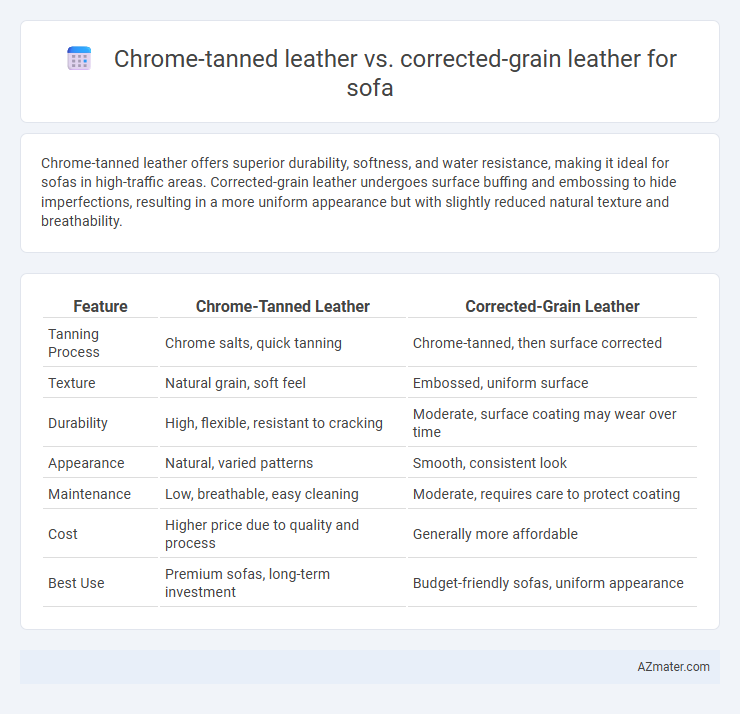Chrome-tanned leather offers superior durability, softness, and water resistance, making it ideal for sofas in high-traffic areas. Corrected-grain leather undergoes surface buffing and embossing to hide imperfections, resulting in a more uniform appearance but with slightly reduced natural texture and breathability.
Table of Comparison
| Feature | Chrome-Tanned Leather | Corrected-Grain Leather |
|---|---|---|
| Tanning Process | Chrome salts, quick tanning | Chrome-tanned, then surface corrected |
| Texture | Natural grain, soft feel | Embossed, uniform surface |
| Durability | High, flexible, resistant to cracking | Moderate, surface coating may wear over time |
| Appearance | Natural, varied patterns | Smooth, consistent look |
| Maintenance | Low, breathable, easy cleaning | Moderate, requires care to protect coating |
| Cost | Higher price due to quality and process | Generally more affordable |
| Best Use | Premium sofas, long-term investment | Budget-friendly sofas, uniform appearance |
Introduction to Chrome-Tanned and Corrected-Grain Leather
Chrome-tanned leather, treated with chromium salts, offers enhanced durability, flexibility, and resistance to stains, making it a popular choice for sofas in modern interiors. Corrected-grain leather undergoes a surface treatment that removes imperfections, followed by an artificial embossing to create a uniform texture, providing a sleek and consistent appearance while sacrificing some natural grain characteristics. Both leathers balance aesthetics and practicality, with chrome-tanned leather excelling in softness and longevity, while corrected-grain leather delivers a refined, blemish-free finish suitable for high-traffic living spaces.
Understanding Chrome-Tanned Leather
Chrome-tanned leather for sofas undergoes a chemical tanning process using chromium salts, resulting in a durable, flexible, and water-resistant material that retains its natural texture and softness. This tanning method allows the leather to age gracefully while maintaining vibrant colors and resistance to wrinkles and fading. In contrast, corrected-grain leather is sanded and treated to remove imperfections, producing a more uniform appearance but sacrificing some natural breathability and character.
What is Corrected-Grain Leather?
Corrected-grain leather is a type of leather that has been sanded or buffed to remove surface imperfections, then coated with an artificial layer to create a uniform appearance. Unlike chrome-tanned leather, which retains its natural grain and softness due to the chromium tanning process, corrected-grain leather undergoes extensive surface treatment, making it more durable but less breathable. This makes corrected-grain leather sofas resistant to stains and scratches, ideal for high-traffic areas yet often less luxurious in texture compared to chrome-tanned leather furniture.
Appearance and Texture Differences
Chrome-tanned leather exhibits a soft, supple texture with a natural, uniform surface and vibrant color variations, ideal for luxurious sofa finishes. Corrected-grain leather features a more uniform, embossed texture designed to mask natural imperfections, resulting in a smoother but less natural appearance. The distinct surface treatments influence the tactile feel, with chrome-tanned leather offering a richer, more authentic touch compared to the processed finish of corrected-grain leather.
Durability: Which Leather Lasts Longer?
Chrome-tanned leather offers superior durability compared to corrected-grain leather, as its tanning process enhances resistance to wear and moisture, making it ideal for high-use sofas. Corrected-grain leather, while visually appealing due to surface treatments and embossing, often sacrifices longevity as these coatings can wear off over time, exposing weaker hide underneath. For long-lasting sofa upholstery, chrome-tanned leather consistently outperforms corrected-grain leather in maintaining structural integrity and appearance.
Comfort and Feel: User Experience Compared
Chrome-tanned leather offers a softer, more supple feel that adapts quickly to body heat, enhancing comfort for prolonged sitting. Corrected-grain leather tends to be firmer with a uniform texture due to its surface treatment, providing durability but a less natural touch. Users often prefer chrome-tanned leather for a luxurious, breathable experience, while corrected-grain leather suits those prioritizing low maintenance and resistance to wear.
Maintenance and Care Requirements
Chrome-tanned leather offers enhanced durability and resistance to stains, requiring simple maintenance with regular dusting and occasional use of mild leather cleaners to preserve its softness and color. Corrected-grain leather, treated to remove imperfections and often coated with protective finishes, necessitates more frequent cleaning and conditioning to prevent cracks and maintain its appearance due to its less natural surface texture. Both types benefit from avoiding direct sunlight and high humidity to extend their lifespan and keep the sofa looking its best.
Environmental Impact of Each Leather Type
Chrome-tanned leather, widely used in sofa manufacturing, relies on chromium salts, which pose significant environmental hazards due to toxic waste and water pollution during tanning processes. Corrected-grain leather, often derived from top-grain hides that undergo heavy sanding and buffing, typically involves additional chemical treatments including dyes and pigments that can contribute to environmental degradation. Sustainable alternatives or vegetable-tanned leather are preferable for sofas seeking lower environmental impact since they avoid hazardous chemicals and reduce pollution.
Cost Comparison: Chrome-Tanned vs Corrected-Grain
Chrome-tanned leather generally costs less than corrected-grain leather due to its faster tanning process and lower labor intensity. Corrected-grain leather involves additional processing to smooth imperfections, increasing both material and production expenses. Consumers often pay a premium for corrected-grain leather because of its refined appearance and durability, despite the higher price compared to chrome-tanned options.
Choosing the Right Leather for Your Sofa
Chrome-tanned leather offers exceptional durability and a soft, supple feel, making it ideal for sofas that require both comfort and long-lasting wear resistance. Corrected-grain leather features a sanded and embossed surface that masks imperfections, providing a more uniform appearance but often sacrificing some natural texture and breathability. Choosing between the two depends on whether you prioritize the natural characteristics and aging potential of chrome-tanned leather or the consistent look and easier maintenance of corrected-grain leather for your sofa.

Infographic: Chrome-tanned leather vs Corrected-grain leather for Sofa
 azmater.com
azmater.com